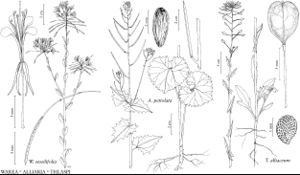Difference between revisions of "Thlaspi alliaceum"
Sp. Pl. 2: 646. 1753.
imported>Volume Importer |
imported>Volume Importer |
||
| Line 55: | Line 55: | ||
|publication year=1753 | |publication year=1753 | ||
|special status=Introduced;Illustrated | |special status=Introduced;Illustrated | ||
| − | |source xml=https:// | + | |source xml=https://bitbucket.org/aafc-mbb/fna-data-curation/src/2e0870ddd59836b60bcf96646a41e87ea5a5943a/coarse_grained_fna_xml/V7/V7_1314.xml |
|tribe=Brassicaceae tribe Thlaspideae | |tribe=Brassicaceae tribe Thlaspideae | ||
|genus=Thlaspi | |genus=Thlaspi | ||
Latest revision as of 22:31, 5 November 2020
Plants mostly glabrous, sparsely to densely pubescent basally along stem, trichomes to 2 mm. Stems (1.2–)2.5–6.5(–7.5) dm. Basal leaves (withered in fruit) laxly rosulate; petiole (0.5–)1–4(–6) cm; blade spatulate, obovate, or oblong-oblanceolate, 0.5–3.5 cm × 6–20 mm, bases attenuate or cuneate, margins entire, repand, or sinuate-dentate, apex rounded. Cauline leaves: blade oblong, 1–4.5 cm × 2–10 mm, apex obtuse or subacute. Fruiting pedicels straight or slightly recurved, (6–)9–12(–16) mm. Flowers: sepals 1.2–2.6 × 0.7–1.2 mm; petals 2.5–4 × 1–1.7 mm, narrowed to clawlike base, apex obtuse; filaments 1.2–2 mm; anthers 0.2–0.4 mm. Fruits obovate or narrowly obcordate, 5–7.5 × 3.7–5.5 mm, base cuneate, apex shallowly emarginate, notch to 0.5 mm deep; wings obscure basally, to 1 mm wide apically; ovules 6–10 per ovary; style 0.1–0.3 mm. Seeds 1.2–1.4 × 0.9–1 mm, alveolate. 2n = 14.
Phenology: Flowering Apr–May.
Habitat: Roadsides, grassy shoulders, fields, waste ground, pastures
Elevation: 0-600 m
Distribution

Introduced; Del., Ind., Ky., La., Md., N.C., Ohio, Pa., Tenn., Va., W.Va., Europe.
Discussion
Thlaspi alliaceum has a garlic-like smell when fresh.
Selected References
None.
